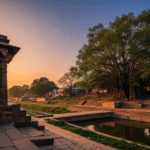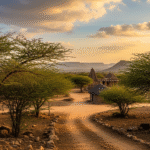Did you know about Amritsar’s population growth? Its numbers soared from over 1.1 million in 2011 to nearly 2 million now. This city is not just packed with people. It’s also Punjab’s second largest. Every day, it draws close to a hundred thousand visitors.
Amritsar is famous for the Golden Temple. But there’s more to its story, from its founding by Guru Ram Das to the heartbreaking Jallianwala Bagh event. As part of the HRIDAY scheme, Amritsar’s old beauty and holy places tell tales. They speak of deep faith and tough times.
Key Takeaways
- Amritsar has a population density of 8,300/km², making it a bustling center of life and culture.
- The city receives a hundred thousand visitors daily, showcasing its appeal as a major tourist destination.
- Amritsar was fortified by Maharaja Ranjit Singh in 1822, significantly influencing its modern structure.
- Chosen under the HRIDAY program, the city focuses on the preservation and renewal of its historical sites.
- The Jallianwala Bagh massacre remains one of the most poignant events in Amritsar’s history.
The Foundation of Amritsar and its Historical Significance
Amritsar is a city with deep spiritual and historical roots. It was founded in 1577 by Guru Ram Das. He was the fourth Guru of the Sikhs. This event was more than just creating a place. It marked the beginning of a spiritual and cultural journey. The city became a key center for Sikhism and business.
Origin of the Name
The name “Amritsar” comes from “Amrita Saras,” which means “Pool of the Nectar.” For Sikhs, the name is very special. The holy tank, first dug by Guru Ram Das, is a cornerstone of the city’s legacy. This sacred pool is a place of peaceful holiness. It draws visitors from all over the world.
Guru Ram Das and the Sacred Pool
In 1577, Guru Ram Das started digging the sacred pool. This task was about more than just making a water spot. It aimed to create a place of spiritual refuge. The pool became the heart of Amritsar, showing its important history. Over time, it turned into the location of the beautiful Golden Temple. This symbolizes the blend of faith and community.
Impact of Mughal Emperor Akbar
Mughal Emperor Akbar’s generosity helped Amritsar grow. He gave the land for the city. This kindness is a key part of Amritsar’s long story. It mixed the tales of Sikhism and Mughal leadership. The land from Akbar became a place for deep meditation. It prepared the city to be an important spot in Sikh faith and history. This time showed how different cultures worked together in Amritsar.
So, Amritsar is more than just a place. It’s a reflection of a rich mix of spiritual, cultural, and political stories. Its foundation is an important chapter. It shows the city’s long-standing meaning and legacy.
The Marvel of the Golden Temple
The Golden Temple, or Sri Harmandir Sahib, is a beautiful symbol of faith and design. It draws millions from around the world to Amritsar, India. They come to worship and see its beauty.
Initial Construction
Golden Temple construction started in 1581, thanks to Guru Arjan Dev Ji, the fifth Sikh Guru. It took eight years to finish, ending in 1604. The temple became more than a place to pray. It showed Sikh history and welcomed everyone, showing equality.
The Role of Maharaja Ranjit Singh
In the 1800s, Maharaja Ranjit Singh made the temple even more stunning. Known as the “Lion of Punjab,” he decided to give the temple a gold look. He used over 500 kg of pure gold.
By 1830, the temple had its gold cover, making it the “Golden Temple.” It got beautiful marble walls and gold designs too. Thanks to Maharaja Ranjit Singh, it became a place of peace and beauty.
The Architectural Splendor of the Golden Temple
The Golden Temple in Amritsar is a stunning work of art. It mixes beautiful design with deep spiritual meaning. Officially called Harmandir Sahib, it blends Hindu and Islamic styles in a unique way.
Blend of Hindu and Islamic Styles
The Golden Temple’s design shows amazing skill. It has parts from both Hindu and Islamic ways. Hindu designs and Islamic patterns make it look amazing. This mix shows Sikhism’s open heart, bringing different spiritual paths together.
Gold Foil Covering and Renovations
The gold foil on the Golden Temple stands out. Maharaja Ranjit Singh first added the gold in the 1800s. Since then, it’s been fixed up many times. One big fix-up in the 1990s used 500 kg of pure gold. It took four years, from 1995 to 1999. Artisans from all over India worked on it. These efforts kept the temple’s beauty and history alive.
Significance of the Harmandir Sahib
Harmandir Sahib means more than its looks. It’s at the heart of Sikh faith and is very sacred. It has four doors. This shows it’s open to everyone, no matter their background. People come for its beauty and its welcoming, peaceful space.
It’s a symbol of love and togetherness, touching the hearts of millions every year.
For more info on the Golden Temple’s beauty and history, go to this guide.
The Golden Temple shares its beauty and spirit with the world. It will keep inspiring and uniting people for many years.
Secret Spots in Amritsar You Must Visit
Amritsar is full of history and culture. It has many hidden gems that show its past. Some hidden places are Jallianwalla Bagh Historical Park and Ram Bagh. These spots have the Summer Palace of Ranjit Singh. They show a side of Amritsar not many know about.
Jallianwalla Bagh Historical Park
Jallianwalla Bagh remembers a sad event from April 13, 1919. On that day, many Indians were killed by British soldiers. This led India to fight for independence. Now, it’s a place where people come to honor those lost and learn history.
Ram Bagh and Summer Palace of Ranjit Singh
Ram Bagh is a green escape near the Golden Temple. It has the Summer Palace of a Sikh leader, Ranjit Singh. The palace shows how Maharaja Ranjit Singh lived. It’s a window into Amritsar’s rich history.
“Ram Bagh, with its scenic beauty and historic Summer Palace, is a peaceful spot. It’s perfect for those wanting to uncover Amritsar’s secrets,” says a local historian.
Ram Bagh Gate connects this site to the Golden Temple and the Summer Palace. These places are important but not well-known parts of Amritsar.
| Place | Historical Significance | Current Use |
|---|---|---|
| Jallianwalla Bagh | Site of 1919 massacre | National Monument |
| Summer Palace of Ranjit Singh | Residence of Maharaja Ranjit Singh | Museum and Garden |
Visiting these places offers a deep look into Amritsar’s history. Jallianwalla Bagh and the Summer Palace of Ranjit Singh are must-sees. They are some of Amritsar’s hidden treasures.
The Spiritual Essence of Amritsar
The spiritual heart of Amritsar beats through its deep traditions and devout acts. The Guru Granth Sahib is at this heart. It is a sacred book for Sikhs everywhere.
Guru Granth Sahib and Daily Routines
The daily life around the Guru Granth Sahib in Amritsar shows deep spiritual love. It is honored in the Golden Temple early each morning. It stays central to all religious acts during the day.
Followers offer Seva (selfless service), including temple care and script readings. This daily love shows Amritsar’s spiritual side. It mixes faith with discipline.
The Largest Langar Seva in the World
The Langar Seva at the Golden Temple shows caring and equality. Sikhism’s core values. It feeds about 100,000 people every day. Everyone is welcome, no matter their background.
This huge kitchen works non-stop. It symbolizes Amritsar’s spirit. It brings people together and spreads kindness.
These acts highlight selfless giving. They remind us that in the divine eyes, everyone is equal and loved.
| Pillar | Description |
|---|---|
| Guru Granth Sahib in Amritsar | The central scripture of Sikhism, continuously recited in the Golden Temple. |
| Daily Seva | Acts of selfless service performed by devotees including cleaning and scripture recitations. |
| Golden Temple’s Langar Seva | A community kitchen that feeds approximately 100,000 people daily, emphasizing equality and unity. |
Interesting Facts about the Golden Temple
The Golden Temple, also known as Harmandir Sahib, is a major spiritual place. Millions visit it every year. It started being built in 1581 and finished in 1604. It’s very important for history and spirituality.
Lord Buddha’s Connection
Before the Sikh era, Lord Buddha visited the Golden Temple site. This connects Lord Buddha and the Golden Temple. He meditated here, showing its spiritual value even before Sikh times.
Baba Deep Singh’s Martyrdom
Baba Deep Singh is a celebrated hero of the Golden Temple. He showed great courage and made a huge sacrifice. His story is a big part of the temple’s history. It shows a strong spirit of faith and courage.

Open to All Religions
The Golden Temple has always welcomed everyone. Guru Arjan Dev started this by inviting Mian Mir, a Sufi saint, in 1588. He laid the foundation stone. This showed the Golden Temple inclusion belief.
It has doors open from all four sides. This means all seeking spiritual peace are welcome.
Hidden Facts About Amritsar
The *uncovered secrets of Amritsar* show more than the famous Golden Temple. It holds a deep history and culture. In its busy streets and quiet alleys, *concealed facts about Amritsar* tell a story of toughness, new ideas, and strong spirit.
Textile Industry: Amritsar is famous worldwide for its textiles. It makes beautiful shawls, suits, and Punjabi clothes. The fine designs and quality have given Amritsar respect in fashion. This industry highlights the city’s creativity and boosts its economy.
Air and Road Connectivity: The Sri Guru Ram Dass Jee International Airport opens Amritsar to the world. An excellent road network connects Amritsar within Punjab, too. These make the city easy to reach for all.
Cultural Shifts Post-Partition: After India split, many refugees came to Amritsar. This increased the Sikh people, but other groups decreased. These changes deeply affected Amritsar’s social and cultural life.
Festivals and Martial Arts: Baisakhi, a huge harvest festival, is joyfully celebrated in Amritsar. The city also shines in Sikh martial arts, or Gatka, showing the bravery of the Sikh people.
Musical Heritage: Amritsar has birthed famous Punjabi musicians who enriched Indian music. The city’s rich musical traditions continue to charm people everywhere.
| Hidden Facts | Details |
|---|---|
| Foundation of Golden Temple | The foundation stone was laid by Sant Mian Mir Ji on 28 December 1588. |
| Gold Adornment | The shrine is adorned with 750 kg of pure gold. |
| Holy Pool | The name Amritsar originates from ‘Amrit’ meaning nectar and ‘Sar’ meaning pool. |
| Temple’s Architecture | The main temple is built below ground level, requiring visitors to descend stairs. |
| Open Entrances | Four entrances symbolize openness to all castes, religions, and creeds. |
| Largest Free Kitchen | Golden Temple houses the largest free community kitchen, feeding fifty thousand people daily. |
| Sacred Pool Depth | The depth of the holy pool is between 17-18 feet, receiving water from the river Ravi. |
| Karah Prashad | Distribution of Karah Prashad is believed to offer various health benefits. |
In *discovering Amritsar*, these hidden treasures and stories give us a fuller vision. They show the city’s rich past, lively industries, and vibrant culture.
Amritsar’s Role in Sikh History and Culture
Amritsar is very important for Sikh history and culture. It is the main place for Sikhism in the world. Founded by Guru Ram Das in 1577, it has become a key site for pilgrimage and cultural heritage.
Establishment of the Akal Takht
The Akal Takht was started by Guru Hargobind in 1606. It is very important in Sikhism. It’s in the Golden Temple complex and is the top authority for Sikhs.
It deals with the religion’s spiritual and worldly matters. It stands for Sikh justice and resistance. This makes Amritsar very important for Sikh leadership and identity.
Golden Temple as a Pilgrimage Site
The Golden Temple is the top place for Sikh pilgrims. Every year, millions come here. It is a symbol of faith and staying strong.
People find peace and spiritual comfort here. The temple’s langar feeds 100,000 people daily for free. This shows the Sikh value of helping others.

| Aspect | Details |
|---|---|
| Foundation Year | 1577 |
| Key Founder | Guru Ram Das |
| Primary Religious Authority | Akal Takht |
| Number of Meals Served | Approximately 100,000 Daily |
Legacy of Amritsar in Modern Times
Modern Amritsar is now a big center combining old history and today’s life. It’s 428 years old. It shows us how people have overcome hard times. Located within the walled city, it has a small area but many people live there. This place keeps its history alive while growing new parts.
Places like the Golden Temple and Jallianwala Bagh make Amritsar important today. Every day, 1 lakh people visit the Golden Temple. Once green areas are now shops and offices. Still, with 52 old buildings, keeping history alive is key. This is tough as many old buildings are not in good shape.
Education is also key in Amritsar. Guru Nanak Dev University is there. It helps the city be smart and cultural. The Golden Temple’s Langar Seva feeds 100,000 people a day, no matter who they are. This shows the city’s kind heart.
Historic places like the Town Hall are in the walled city too. Amritsar mixes work, culture, and learning in a special way. It tells us about India’s past and dreams for tomorrow.
Conclusion
Amritsar is a city full of bravery, faith, and togetherness. It started with Guru Ram Das. He founded the Golden Temple. Leaders like Maharaja Ranjit Singh helped the city grow. This city blends toughness and culture.
Amritsar’s history isn’t just about buildings and holy places. Jallianwala Bagh reminds us of India’s fight for freedom. It has bullet marks from 1919. Millions visit the Golden Temple every year. They join in rituals and the world’s biggest Langar Seva. This shows the city’s love for helping and treating everyone equally.
Amritsar’s legacy is seen everywhere. Walks through the old city share stories. Places like Gobindgarh Fort and Akal Takht add to these tales. Punjab’s lively culture shines through. Foods like Amritsari kulcha and sarson da saag take you on a tasty tour. These treats draw food lovers from everywhere.
Even with problems like pollution, Amritsar keeps its history alive. The government and people are working hard. Visitors, pilgrims, and historians see a city rich in sacrifice and community spirit. Amritsar’s heritage promises to motivate many future generations.
FAQ
What are some lesser-known hidden gems in Amritsar?
Amritsar has many secret spots. These include Ram Bagh Garden and the Summer Palace of Maharaja Ranjit Singh. The Partition Museum is also a must-see. They all show different parts of the city’s rich history and culture.
How was Amritsar founded and what is its historical significance?
In 1577, the fourth Sikh Guru, Guru Ram Das, founded Amritsar. The city began around the sacred pool of Amrita Saras. Mughal Emperor Akbar gave the land, mixing Sikh and Mughal histories. Amritsar became key in spirit and culture from this start.
Can you tell us about the initial construction of the Golden Temple?
Guru Arjan, the fifth Sikh Guru, started building the Golden Temple in 1581. It took eight years to finish. This temple became the main worship place for Sikhs everywhere.
What contributions did Maharaja Ranjit Singh make to the Golden Temple?
In the early 19th century, Maharaja Ranjit Singh covered the Golden Temple in gold. His gifts made the temple more beautiful and important.
How does the Golden Temple showcase a blend of Hindu and Islamic architectural styles?
The Golden Temple beautifully mixes Hindu and Islamic designs. Its detailed work and gold walls show both styles.
What is the significance of the Gold Foil Covering and recent renovations of the Golden Temple?
Maharaja Ranjit Singh first added the Gold Foil. The temple was renovated in the 1990s. About 500 kg of gold was used. These updates made the temple even more stunning.
What makes the Harmandir Sahib significant?
The Harmandir Sahib is at the heart of the Golden Temple. It houses the Guru Granth Sahib. The temple’s four doors welcome everyone. This shows Sikh values of openness and respect.
What are some secret spots in Amritsar that should not be missed?
Amritsar has secret spots beyond the Golden Temple. Jallianwalla Bagh Historical Park and Ram Bagh are great examples. Maharaja Ranjit Singh’s Summer Palace is there too. They offer a peek into Amritsar’s complex history.
What is the significance of the Guru Granth Sahib and the Langar Seva in Amritsar?
The Guru Granth Sahib’s non-stop reading highlights Amritsar’s spiritual heart. The Langar Seva serves about 100,000 people daily. It shows Sikh principles of kindness and community.
Are there any interesting historical facts about the Golden Temple that might surprise visitors?
Many don’t know Lord Buddha meditated where the Golden Temple now stands. The story of Baba Deep Singh is remembered here. Sufi saint Mian Mir laid the temple’s foundation. This shows the temple’s welcoming spirit.
What role does Amritsar play in Sikh history and culture?
Amritsar is key to Sikh history and culture. It’s home to the Akal Takht, Sikhism’s highest seat. The Golden Temple is an unmatched pilgrim site. Both mark Amritsar’s deep cultural roots.
How is Amritsar’s legacy reflected in modern times?
Amritsar is now a big center for trade, culture, and learning. It stays true to its heritage through places like Guru Nanak Dev University. The city also hosts events that celebrate its enduring spirit and community values.










